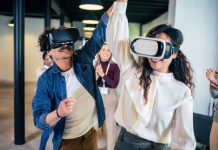
Today’s workforce is going hybrid. Is your training content up for the job? Traditional 2D training formats don’t lend themselves to modern experiential learning. Their design, interaction, and user interface (UI) experience can cause learning and development (L&D) initiatives to fall flat. You must rethink the document status quo and adopt interactive content technology. Let’s show you why.
The Future of the Workforce Is Hybrid
Hybrid workforces have become the norm as society begins to open up after the pandemic. What is a hybrid workforce? A hybrid workforce is a mixed workforce where some people are in the office full time, some people work remotely full time, and others are in the office some of the time. In fact, Upwork estimates that 26 percent of workers will be working remotely through 2021. Furthermore, they estimate that 22 percent of the entire workforce will work remotely by 2025.
This is driven in part by employees preferring to work from home now and for the foreseeable future. A global survey of more than 10,000 knowledge workers by Future Forum, a think tank by Slack, found that the pandemic has changed workers’ expectations about work. The survey found that 93 percent want flexibility in their schedules, while 76 percent want the ability to work in a location of their choosing.
The hybrid mix will increase the difficulty of running traditional training programs. Therefore, you’ll need to up your game to engage and energize hybrid learning. Employees will need interactive, engaging, and consistent learning experiences.
But employees aren’t the only ones to think about. You need tools that are easy to use and easily shared among remote workers. You will need to adopt a multimedia approach, including polls, videos, and the ability to choose personalized learning journeys within the materials.
It’s important to be able to easily create, manage, distribute and revise training materials. You must keep all of this in mind when choosing new training platforms.
Drive Experiential Learning
Today, learning must be experiential. Experiential learning describes the ideal process of learning, invites learners to understand themselves as learners, and empowers them to take charge of their own learning and development.
Learning can occur anywhere, at any time, and is lifelong. A good experiential learning process upholds performance improvement and L&D initiatives. According to David A. Kolb from The Institute for Experiential Learning, “There are two goals in the experiential learning process. One is to learn the specifics of a particular subject, and the other is to learn about one’s own learning process.”
Old 2D training materials just won’t cut it in today’s experiential learning, hybrid world. Content must be flexible and dynamic to support and maintain experiential learning opportunities. That type of learning works best with interactive content that can support multiple media types (e.g., audio, video, etc.) and can be customized with quizzes, polls, and other ways to practice the learner’s new knowledge.
Since people are working from such diverse places as a coffee shop, in their bedroom, or at the office, today’s training needs to be more self-driven and interactive. It must engage and entertain. Unlike static content, interactive content can enable self-driven experiences, increasing engagement and allowing users the freedom to consume and learn in the way that best suits them.
To keep trainees on the same page no matter where they are, you will need a powerful digital content platform to create better learning experiences. Look for one that offers quizzes, polls, and self-directed journeys. Keep in mind that your training is competing with background noise, interruptions, and other disturbances of working from anywhere. You need a platform that is engaging enough to ensure employees actually learn.
Ensure Your Content Is Hybrid Ready
Old systems simply weren’t designed for today’s hybrid training environment. As an L&D professional, you need to find new ways to maintain productivity and meet future goals. It’s going to be a challenge to deliver consistent training and experiential learning for all workers no matter where they work. A successful learning experience needs to be created to engage employees end to end to improve worker skills. You need to rethink the status quo and adopt interactive content technology to drive world-class experiential learning.




